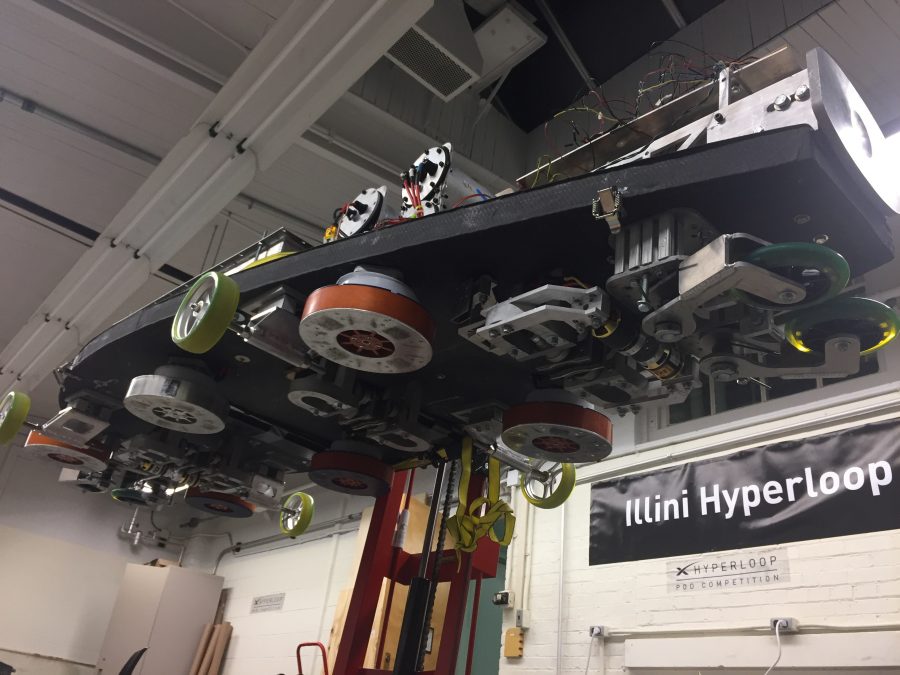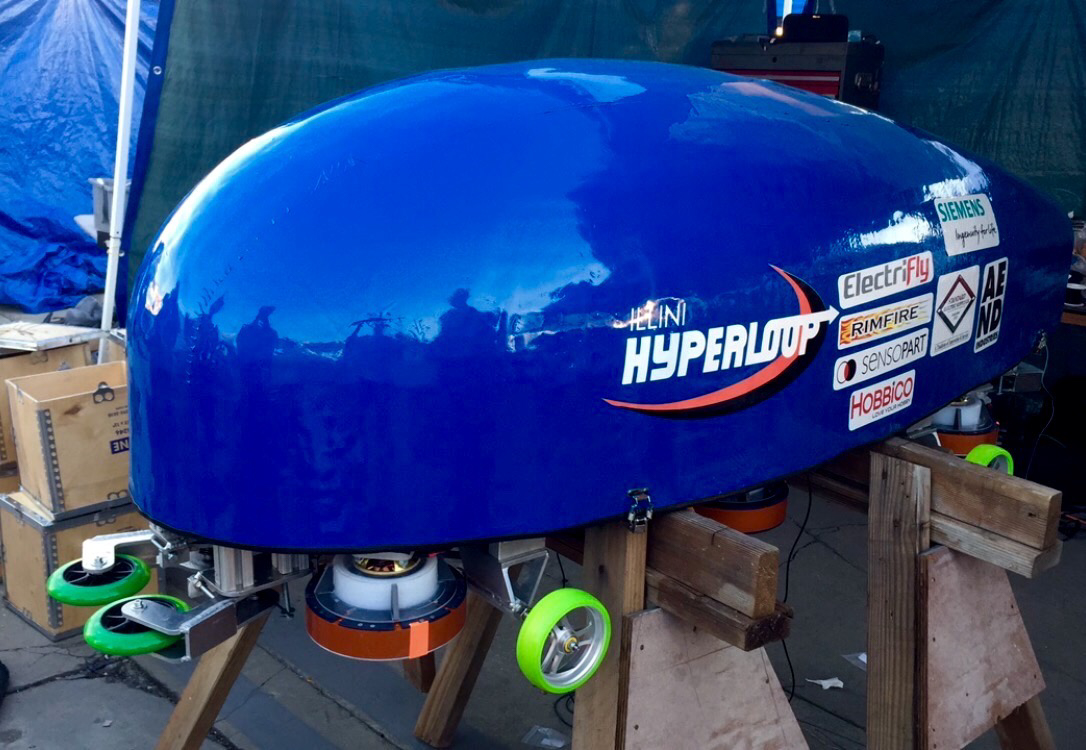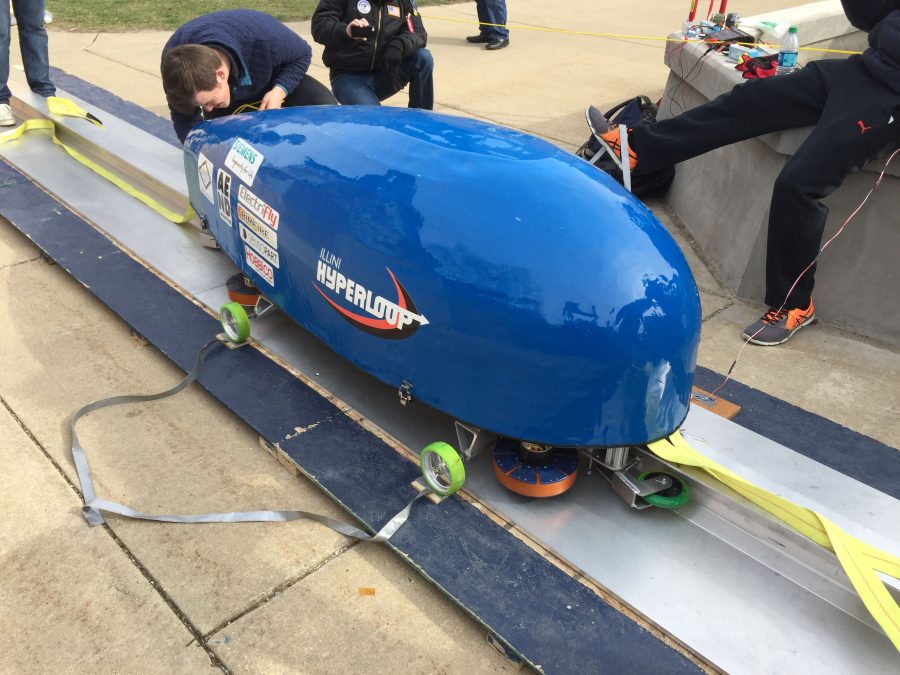Illini Hyperloop advances to second SpaceX competition
Photo Courtesy of Mizan Rahman
Illini Hyperloop members with the original pod they created for SpaceX’s hyperloop competition. The team will be competing in the next SpaceX hyperloop competition later this year.
Apr 12, 2017
The Illini Hyperloop team will be competing in its second SpaceX competition this August after designing their second pod, a new mode of transportation that will potentially revolutionize the way people commute.
The hyperloop is a human-sized pod that travels through a depressurized tube, and it is designed to significantly shorten travel time. Illini Hyperloop participated in the first SpaceX competition in January.
Richard Wendel, head of electronics and sophomore in Engineering, said that the team did not get as far as they wanted in the first competition, but they are still one of the 24 teams that are allowed to compete in the second competition.
There were around 150 teams entering the competition in total.
Mizan Rahman, head of the University’s Senior Design Team and senior in Engineering, said that compared to the first competition, the second one is more geared towards maximum speed.
Get The Daily Illini in your inbox!
He said that the main design goal is to make the pod lighter and faster.
 “We want it to go upwards, a hundred meters per second,” he said. “And in theory, that’s what SpaceX can put us to do, and that’s what other teams are also going to be aiming for, but it’s still up in the air what SpaceX can provide us.”
“We want it to go upwards, a hundred meters per second,” he said. “And in theory, that’s what SpaceX can put us to do, and that’s what other teams are also going to be aiming for, but it’s still up in the air what SpaceX can provide us.”
The team has made changes to the shell of the pod since their first competition, said Wendel. The new one is shorter, thinner and designed to reduce drag. However, the details of the design have to be kept confidential before the competition.
“Our current design for the upcoming competition is the best one that we’ve made,” said Rishab Pohane, Illini Hyperloop president and sophomore in LAS. “It has great winning potential.”
Illini Hyperloop will be building the second pod in the next five weeks, said Rahman. The team is receiving funding from both inside and outside of the school.
“Shell is a potential sponsor at the moment, and we’re talking about some funding from them,” Pohane said. “Hopefully, if that works out, we would have most of what we need to actually get this thing done.”
He said that they would hopefully hear back from Shell later this week.
Pohane said that the idea of creating a hyperloop was announced when he was a senior in high school.
“The first thing that came into my mind is ‘I need to be a part of this as soon as I get to college.’” he said. “Because when I saw the idea and the concept, I knew this mode of transportation will definitely take off at some point. It’s an eventuality.”
The concept of hyperloop aims to solve the problem of traveling distances that are not logistically reasonable, Rahman said.
“Three-hundred miles, around that range is the sweet spot,” Wendel said. “Doesn’t make sense to fly, driving that distance sucks, trains are fine, but they’re kind of slow, but hyperloop is a good idea.”
 Rahman said that their system can be implemented anywhere where there are two neighboring cities, in which case taking a hyperloop would be cheaper than flying.
Rahman said that their system can be implemented anywhere where there are two neighboring cities, in which case taking a hyperloop would be cheaper than flying.
However, the placing of the depressurized tube remains a problem. Rahman said that it will most likely be suspended in the air close to the ground since placing it underground would introduce safety issues.
“In terms of my approximation as to how long we have to wait to see an actual hyperloop, it will probably be about 10 to 15 years,” Pohane said.
He said that the hyperloop concept has gained a lot of attention. Both engineering students and professionals from all over the world are working on developing their own hyperloop systems. However, it not always easy.
“There’s a ton of different problems, but they’re solvable, just like everything,” he said.






